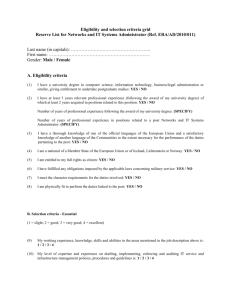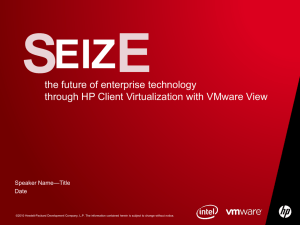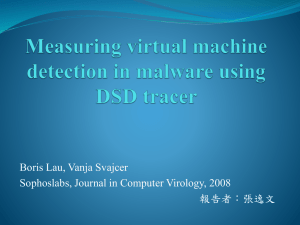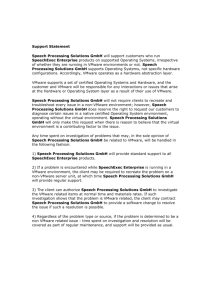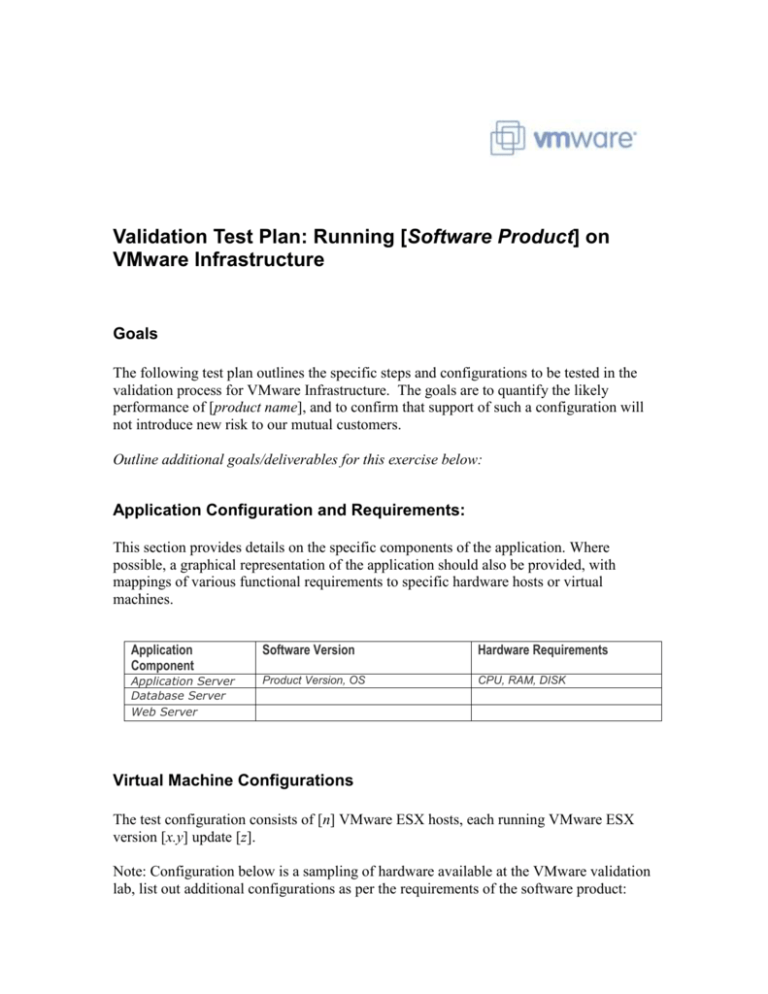
Validation Test Plan: Running [Software Product] on
VMware Infrastructure
Goals
The following test plan outlines the specific steps and configurations to be tested in the
validation process for VMware Infrastructure. The goals are to quantify the likely
performance of [product name], and to confirm that support of such a configuration will
not introduce new risk to our mutual customers.
Outline additional goals/deliverables for this exercise below:
Application Configuration and Requirements:
This section provides details on the specific components of the application. Where
possible, a graphical representation of the application should also be provided, with
mappings of various functional requirements to specific hardware hosts or virtual
machines.
Application
Component
Software Version
Hardware Requirements
Application Server
Database Server
Web Server
Product Version, OS
CPU, RAM, DISK
Virtual Machine Configurations
The test configuration consists of [n] VMware ESX hosts, each running VMware ESX
version [x.y] update [z].
Note: Configuration below is a sampling of hardware available at the VMware validation
lab, list out additional configurations as per the requirements of the software product:
Hardware
DL 580
DL 380
Configuration (ESX)
Virtual Machine
2.93GHz 2 quad-core Intel Xeon
X7350
128GB RAM
4Gb Ethernet card
4 146GB SAS drives
SAN NetApp FAS 3020
Four virtual machines configured as
application servers, each with:
2 vCPUs
2GB memory
1 Ethernet card
30GB storage
3.16GHz 2 quad-core Intel Xeon
7350
32GB RAM
2Gb Ethernet card
4 146GB SAS drives
SAN Net App FAS 3020
Four virtual machines configured as
Web servers, each with:
<vCPU>
<RAM>
<Network>
<Storage>
One virtual machines configured as a
data server with:
<vCPU>
<RAM>
<Network>
<Storage>
460c
460c
2.33GHz 2 Dual core Intel Xeon
5460
16GB RAM
2Gb Ethernet card
2 146GB SAS drives
SAN Net App FAS 3020
One virtual machine configured as an
agent with:
<vCPU>
<RAM>
<Network>
<Storage>
2.33 GHz 2 Dual core Intel Xeon
5460
16GB RAM
2Gb Ethernet card
2 146GB SAS drives
SAN Net App FAS 3020
One primary virtual machine with:
<vCPU>
<RAM>
<Network>
<Storage>
One client (workload driver) virtual
machine with:
<vCPU>
<RAM>
<Network>
<Storage>
Total storage required (for example)
5 Disk Partitions:
25GB for <OS>
100GB for <application>,
backups, flat file storage, page
file
150GB for data files (actual
database size will be in the
50GB range)
75GB for indexes
50GB for logs
Benchmark Workload
This section describes the workload used, the load driver technology, and the specific
functional transactions included.
The workload is based on <load testing tool version x.y>. The workload consists of the
following transaction scripts (provide relevant workload operations below):
Script Name
Create New Ticket
Add Workinfo to Ticket
Delete Ticket
Close Ticket
Escalate ticket
Change User Info
Update Support Team
Frequency of Execution
4 per minute
2 per minute
1 per minute
6 per minute
2 per minute
2 per minute
2 per minute
Percentage of Workload
20%
30%
10%
20%
10%
5%
5%
Driving the load of the workload will be done using <x> virtual machines, each with
<two virtual CPUs and 2GB of RAM>. The test usually runs for <2 hours, with 30
minutes of ramp up, 30 minutes of ramp down, and 60 minutes of steady state execution
where data is to be collected>.
Additional notes: <The database will incrementally grow during these runs, but the
overall volume is consistent enough that performance is not expected to be effected by the
small growth of the database>.
Test Cases
The following usecases will be tested, corresponding to our <medium and large reference
configurations>. Each configuration/workloads is described below: <for example each
configuration, 3 user counts will be attempted, while resources and performance
characteristics are monitored and recorded>
<Medium> Configuration
The medium configuration consists of several virtual machines: two Web servers, two
application servers, a report server, and the database. The test cases to be run and the
data to be collected are as follows:
<User Count>
Ave Response
Time
CPU Utilization
<Database>
Memory
Utilization
<Database>
CPU
Utilization
<Apps tier
VM1>
200
400
800
<Large> Configuration
The large virtual machine configuration consists of 3 Web servers, 3 application servers,
a report server, and the database. The test cases to be run and the data to be collected
are as follows:
<User Count>
Ave Response
Time
400
800
1000
Additional test cases (if any):
CPU Utilization
<Database>
Memory
Utilization
<Database>
CPU
Utilization
<Apps tier
VM1>
(Optionally) VMware Infrastructure Testing
In order to understand how [ISV Product] works with higher level functionality of
VMware Infrastructure, we will perform one or more of the following tests.
VMware vMotion Testing
While running the workload, VMware vMotion is used to execute manual migration of
the database virtual machine from one VMware ESX host to another. During this test,
response time and transaction rates are monitored, and any observed slowdown in
performance is measured. Five such operations will be executed, and averages are then
determined across the five.
VMware Distributed Resource Scheduler (DRS) Testing
During this test, virtual machines are assigned to VMware ESX hosts such that the
majority of the load will be on one host. In the first test, set the aggressiveness level of
VMware DRS to “Conservative.” Start up the test and monitor how VMware DRS moves
virtual machines across a cluster to balance the load. Monitor transaction throughput, as
well as CPU utilization of the various hosts in the cluster. You should see CPU utilization
balance across the hosts with little decrease in throughput. Now run the same test after
setting the aggressiveness of VMware DRS to a substantially higher value. Typical
deliverables are CPU charts from VMware vCenter Server that reflect the balancing of
the load during these tests.
VMware High Availability (HA) Testing
Run the workload on a clustered resource pool, and then do a hard shutdown of one host
of the configuration. Note how the virtual machines come up on another host in the
cluster. Restart the application components if necessary, and functionally verify that the
application is working again. Measure the time it takes for the virtual machine to start
accepting work again. This work is often most interesting in the case of services that start
automatically at reboot, such as Web servers, such that the application will automatically
be ready to work as soon as the virtual machine is restarted on another host.
Wrap-up and Documentation
Where possible, results of testing are documented in a standard format provided by
VMware. This will then be entered into a template for a deployment guide to be used as
a starting place for documenting the results of the testing. Where possible, the virtual
machines used for testing should be archived for possible use in the future. Any
outstanding issues should be documented for further followup with either VMware or
other ISV development teams.
VMware, Inc. 3401 Hillview Ave Palo Alto CA 94304 USA Tel 877-486-9273 Fax 650-427-5001 www.vmware.com
Copyright © 2009 VMware, Inc. All rights reserved. This product is protected by U.S. and international copyright and intellectual property laws. VMware products are
covered by one or more patents listed at http://www.vmware.com/go/patents.
VMware is a registered trademark or trademark of VMware, Inc. in the United States and/or other jurisdictions. All other marks and names mentioned herein may be
trademarks of their respective companies. Item No: 09Q1_VM_Test_Plan_PG4_R1


